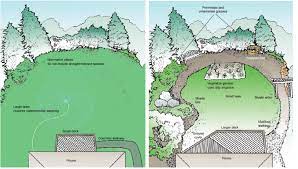Introduction
In a world where water conservation is becoming increasingly critical, xeriscaping emerges as a sustainable solution for landscaping that is both beautiful and environmentally friendly. This method of water-efficient landscaping prioritizes the use of native and drought-tolerant plants, efficient irrigation techniques, and thoughtful hardscaping to create visually appealing outdoor spaces. This article explores the basics of xeriscaping, offering insights into its principles and benefits.
Understanding Xeriscaping Principles
Water Conservation as a Primary Goal
At the core of xeriscaping is the principle of water conservation. The goal is to create landscapes that thrive with minimal water input, reducing reliance on irrigation and preserving this precious resource. Xeriscaping is not about sacrificing beauty but rather embracing sustainable practices to achieve a harmonious balance between aesthetics and environmental responsibility.
Utilizing Native and Drought-Tolerant Plants
Xeriscaping promotes the use of native plants that are naturally adapted to the local climate and require less water. Drought-tolerant plants, with features like deep root systems and water-storing capabilities, play a crucial role in water-efficient landscaping. By selecting plants that are well-suited to the region’s natural conditions, xeriscaped gardens can flourish with minimal irrigation.
Selecting Appropriate Plants for Xeriscaping
Native Plant Options
Choose native plants that are endemic to your region. These plants have evolved to thrive in the specific climate, soil, and water conditions of their native habitat. By incorporating native species into your xeriscape, you ensure that your garden is well-adapted to the local environment, requiring less water and maintenance.
Drought-Tolerant and Low-Water-Use Plants
Explore a variety of drought-tolerant plants that are well-suited for xeriscaping. Succulents, such as agave and sedum, are excellent choices due to their water-storing abilities. Additionally, consider low-water-use plants like lavender, yarrow, and ornamental grasses, which add visual interest while conserving water.
Efficient Irrigation Techniques
Drip Irrigation Systems
Drip irrigation is a key component of xeriscaping, delivering water directly to the base of plants through a network of hoses and emitters. This method minimizes water wastage by avoiding overspray and evaporation. Drip irrigation systems can be automated and adjusted to meet the specific water needs of different plant zones in your xeriscape.
Mulching to Retain Soil Moisture
Mulching is a simple yet effective technique for retaining soil moisture in xeriscaped gardens. Apply a layer of organic mulch, such as wood chips or bark, around plants to reduce evaporation, suppress weeds, and regulate soil temperature. Mulching also contributes to soil health by gradually breaking down and enriching the soil with organic matter.
Soil Improvement for Water Retention
Incorporating Organic Matter
Enhance the water retention capacity of your soil by incorporating organic matter. Compost, well-rotted manure, or other organic amendments improve soil structure, allowing it to retain moisture more effectively. Amending the soil with organic matter also promotes healthier plant growth in xeriscaped areas.
Implementing Proper Soil Grading
Ensure proper soil grading to prevent water runoff and encourage water absorption. Grading should direct water toward planted areas, preventing erosion and maximizing water retention. Consider the natural slope of your landscape and adjust the soil grade accordingly to optimize water distribution.
Lawn Alternatives in Xeriscaping
Ground Covers and Ornamental Grasses
In xeriscaping, consider alternatives to traditional lawns by incorporating ground covers and ornamental grasses. These low-maintenance options provide visual interest while reducing the need for frequent watering. Ground covers like creeping thyme or stonecrop are excellent choices for xeriscape designs.
Reducing or Eliminating Traditional Lawns
Consider reducing or eliminating traditional lawns in favor of water-efficient alternatives. Large expanses of grass demand significant water inputs and maintenance. Replace parts of your lawn with hardscaping, ground covers, or drought-tolerant plants to create a more sustainable and visually diverse xeriscape.
Hardscaping and Water Features
Using Permeable Materials for Pathways
Choose permeable materials for pathways and hardscaped areas in your xeriscape. Permeable materials, such as gravel or permeable pavers, allow water to penetrate the soil, reducing runoff and supporting groundwater recharge. This contributes to water conservation while adding texture and functionality to your landscape.
Incorporating Water-Efficient Features Like Rain Gardens
Integrate water-efficient features like rain gardens into your xeriscape design. A rain garden is a planted depression that captures and filters rainwater runoff. By channeling rainwater into designated areas with carefully selected plants, you enhance water absorption and reduce the impact of stormwater runoff on local ecosystems.
Maintenance Practices for Xeriscaped Gardens
Regular Monitoring and Adjustments
Monitor your xeriscape regularly to assess the health of plants, check irrigation systems, and identify any issues. Adjust watering schedules based on seasonal variations and plant needs. Regular monitoring allows you to make timely adjustments and ensure the ongoing success of your water-efficient landscape.
Proper Pruning and Weeding Techniques
Practice proper pruning and weeding to maintain the aesthetic appeal of your xeriscape. Pruning encourages healthy growth and shape, while strategic weeding prevents invasive plants from competing with your chosen species. Adopting these practices reduces the need for excessive water and promotes a well-maintained xeriscape.
Educating Homeowners on Xeriscaping Benefits
Reducing Water Consumption and Bills
Highlight the economic benefits of xeriscaping to homeowners. By significantly reducing water consumption, xeriscaped gardens contribute to lower water bills. This financial incentive encourages more individuals to embrace water-efficient landscaping practices.
Contributing to Environmental Conservation
Educate homeowners on the broader environmental impact of xeriscaping. By conserving water, xeriscaped gardens contribute to the preservation of local water resources, support biodiversity, and mitigate the environmental stress associated with excessive water use in traditional landscaping.
Conclusion
In conclusion, xeriscaping is a sustainable and visually appealing approach to landscaping that prioritizes water efficiency. By understanding the principles of xeriscaping, selecting appropriate plants, implementing efficient irrigation techniques, improving soil retention, considering alternatives to traditional lawns, incorporating hardscaping, and adopting proper maintenance practices, homeowners can create landscapes that thrive with minimal water input. The benefits extend beyond individual gardens, contributing to broader environmental conservation efforts. Embrace the basics of xeriscaping, and enjoy a beautiful, water-efficient landscape that makes a positive impact on both your surroundings and the planet.
FAQs
- Can I have a visually appealing garden with xeriscaping?
- Absolutely! Xeriscaping emphasizes aesthetic design while prioritizing water-efficient practices, creating visually stunning landscapes.
- What are some examples of drought-tolerant plants for xeriscaping?
- Drought-tolerant plants include succulents like agave and sedum, as well as low-water-use plants like lavender, yarrow, and ornamental grasses.
- How can I reduce water runoff in my xeriscape?
- Use permeable materials for pathways, consider rain gardens to capture runoff, and ensure proper soil grading to prevent water runoff.
- Is xeriscaping suitable for all climates?
- Yes, xeriscaping principles can be adapted to various climates, emphasizing the use of native and drought-tolerant plants suitable for specific regions.
- What financial benefits come with xeriscaping for homeowners?
- Homeowners can significantly reduce water consumption and, consequently, lower their water bills by embracing xeriscaping practices.

